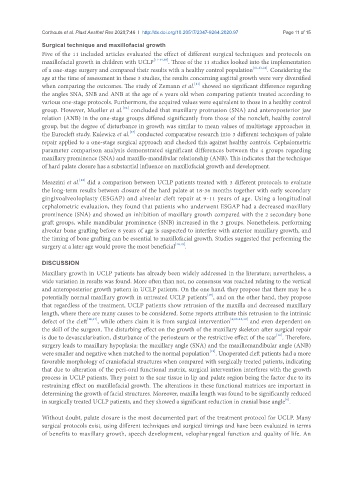Page 525 - Read Online
P. 525
Corthouts et al. Plast Aesthet Res 2020;7:46 I http://dx.doi.org/10.20517/2347-9264.2020.97 Page 11 of 15
Surgical technique and maxillofacial growth
Five of the 11 included articles evaluated the effect of different surgical techniques and protocols on
maxillofacial growth in children with UCLP [11-14,18] . Three of the 11 studies looked into the implementation
of a one-stage surgery and compared their results with a healthy control population [11,13,14] . Considering the
age at the time of assessment in these 3 studies, the results concerning sagittal growth were very diversified
[11]
when comparing the outcomes. The study of Zemann et al. showed no significant difference regarding
the angles SNA, SNB and ANB at the age of 6 years old when comparing patients treated according to
various one-stage protocols. Furthermore, the acquired values were equivalent to those in a healthy control
[14]
group. However, Mueller et al. concluded that maxillary protrusion (SNA) and anteroposterior jaw
relation (ANB) in the one-stage groups differed significantly from those of the noncleft, healthy control
group, but the degree of disturbance in growth was similar to mean values of multistage approaches in
[13]
the Eurocleft study. Kulewicz et al. conducted comparative research into 3 different techniques of palate
repair applied to a one-stage surgical approach and checked this against healthy controls. Cephalometric
parameter comparison analysis demonstrated significant differences between the 4 groups regarding
maxillary prominence (SNA) and maxillo-mandibular relationship (ANB). This indicates that the technique
of hard palate closure has a substantial influence on maxillofacial growth and development.
Meazzini et al. did a comparison between UCLP patients treated with 3 different protocols to evaluate
[12]
the long-term results between closure of the hard palate at 18-36 months together with early secondary
gingivoalveoloplasty (ESGAP) and alveolar cleft repair at 9-11 years of age. Using a longitudinal
cephalometric evaluation, they found that patients who underwent ESGAP had a decreased maxillary
prominence (SNA) and showed an inhibition of maxillary growth compared with the 2 secondary bone
graft groups, while mandibular prominence (SNB) increased in the 3 groups. Nonetheless, performing
alveolar bone grafting before 8 years of age is suspected to interfere with anterior maxillary growth, and
the timing of bone grafting can be essential to maxillofacial growth. Studies suggested that performing the
surgery at a later age would prove the most beneficial [14,18] .
DISCUSSION
Maxillary growth in UCLP patients has already been widely addressed in the literature; nevertheless, a
wide variation in results was found. More often than not, no consensus was reached relating to the vertical
and anteroposterior growth pattern in UCLP patients. On the one hand, they propose that there may be a
[15]
potentially normal maxillary growth in untreated UCLP patients , and on the other hand, they propose
that regardless of the treatment, UCLP patients show retrusion of the maxilla and decreased maxillary
length, where there are many causes to be considered. Some reports attribute this retrusion to the intrinsic
defect of the cleft [16,17] , while others claim it is from surgical intervention [6,13-15,19] and even dependent on
the skill of the surgeon. The disturbing effect on the growth of the maxillary skeleton after surgical repair
is due to devascularization, disturbance of the periosteum or the restrictive effect of the scar . Therefore,
[16]
surgery leads to maxillary hypoplasia: the maxillary angle (SNA) and the maxillomandibular angle (ANB)
[19]
were smaller and negative when matched to the normal population . Unoperated cleft patients had a more
favorable morphology of craniofacial structures when compared with surgically treated patients, indicating
that due to alteration of the peri-oral functional matrix, surgical intervention interferes with the growth
process in UCLP patients. They point to the scar tissue in lip and palate region being the factor due to its
restraining effect on maxillofacial growth. The alterations in these functional matrices are important in
determining the growth of facial structures. Moreover, maxilla length was found to be significantly reduced
in surgically treated UCLP patients, and they showed a significant reduction in cranial base angle .
[6]
Without doubt, palate closure is the most documented part of the treatment protocol for UCLP. Many
surgical protocols exist, using different techniques and surgical timings and have been evaluated in terms
of benefits to maxillary growth, speech development, velopharyngeal function and quality of life. An

